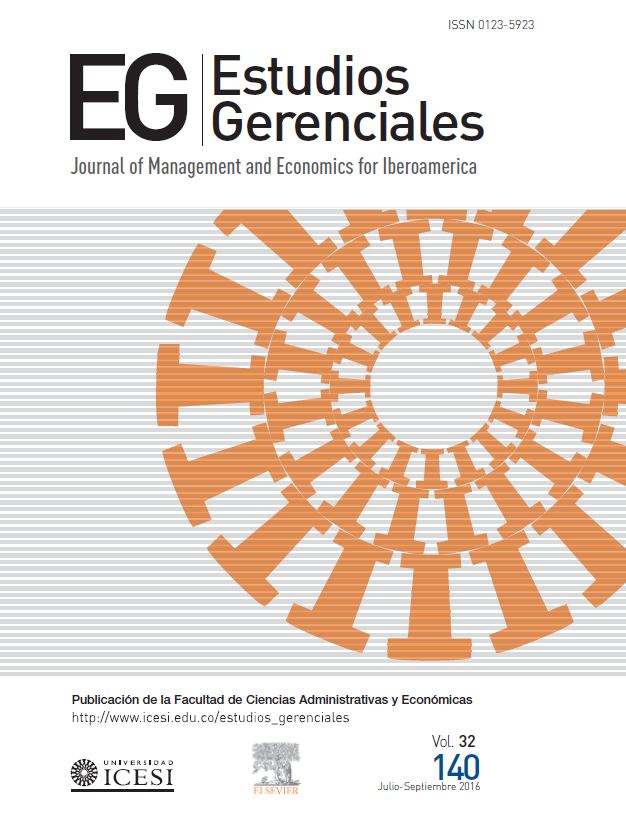An analysis on operational risk in international banking: A Bayesian approach (2007–2011)
DOI:
https://doi.org/10.1016/j.estger.2016.06.004Palavras-chave:
Operational risk, Bayesian analysis, Monte Carlo simulationResumo
This study aims to develop a Bayesian methodology to identify, quantify and measure operational risk in several business lines of commercial banking. To do this, a Bayesian network (BN) model is designed with prior and subsequent distributions to estimate the frequency and severity. Regarding the subsequent distributions, an inference procedure for the maximum expected loss, for a period of 20 days, is carried out by using the Monte Carlo simulation method. The business lines analyzed are marketing and sales, retail banking and private banking, which all together accounted for 88.5% of the losses in 2011. Data was obtained for the period 2007–2011 from the Riskdata Operational Exchange Association (ORX), and external data was provided from qualified experts to complete the missing records or to improve its poor quality.
Downloads
Referências
Alexander, C. (2002). Operational risk measurement: Advanced approaches. UK: ISMA Centre. University of Reading. Retrieved from: http://www.dofin.ase.ro/Lectures/Alexander%20Carol/Oprisk Bucharest.pdf
Artzner, P., Delbaen, F., Eber, J., & Heath, D. (1999). Coherent measures of risk. Mathematical Finance, 9(3), 203–228.
Basel II. (2001a). Operational risk. Consultative document. Retrieved from: https://www.bis.org/publ/bcbsca07.pdf
Basel II. (2001b). Working paper on the regulatory treatment of operational risk. Retrieved from: http://www.bis.org/publ/bcbswp8.pdf
Carrillo-Menéndez, S., & Suárez-González, A. (2015). Challenges in operational risk modelling. In International Model Risk Management Conference. Retrieved from: http://imrmcon.org/wp-content/uploads/2015/06/CS-5BModel-Risk-Within-Operational-Risk1.pdf
Carrillo-Menéndez, S., Marhuenda-Menéndez, M., & Suárez-González, A. (2007). El entorno AMA (Advanced Model Approach). Los datos y su tratamiento. In Ana Fernández-Laviada (Ed.), La gestión del riesgo operacional: de la teoría a su aplicación. Santander: Universidad de Cantabria.
Cowell, R., Dawid, G., Lauritzen, A. P., & Spiegelhalter, D. J. (1999). Probabilistic networks and expert systems. Berlin: Springer-Verlag.
Cruz, M. G. (2002). Modeling, measuring and hedging operational risk. In Series Wiley Finance. West Sussex, UK: John Wiley & Sons.
Cruz, M. G., Peters, G. W., & Shevchenko, P. V. (2002). Fundamental aspects of operational risk and insurance analytics: A handbook of operational risk. New York: John Wiley & Sons.
Degen, M., Embrechts, P., & Lambrigger, D. (2007). The quantitative modeling of operational risk: Between g-and-h and EVT. Switzerland: Department of Mathematics, ETH Zurich, CH-8092 Zurich. Retrieved from: https://people.math.ethz.ch/~embrecht/ftp/g-and-hMay07.pdf
Embrechts, P., Furrer, H., & Kaufmann, O. (2003). Quantifying regulatory capital for operational risk. Derivatives Use, Trading and Regulation, 9(3), 217–233.
Ferguson, T. S. (1973). A Bayesian analysis of some nonparametric problems. Annals of Statistics, 2(4), 615–629.
Guo, H., & Hsu, W. (2002). A survey of algorithms for real-time Bayesian network inference. In Join Workshop on Real Time Decision Support and Diagnosis Systems.
Heinrich, G. (2006). Riesgo operacional, pagos, sistemas de pago y aplicación de Basilea II en América Latina: evolución más reciente. Boletín del CEMLA. Retrieved from: https://www.bis.org/repofficepubl/heinrich_riesgo_operacional_a.pdf
Jensen, F. V. (1996). An introduction to Bayesian networks (1st ed.). London: UCL Press.
Kartik, A., & Reimer, K. (2007). Phase transitions in operational risk. Physical Review E, 75(1 part 2), 1–14.
Lauritzen, S. L., & Spiegelhalter, D. J. (1988). Local computations with probabilities on graphical structures and their application to expert systems. Journal of Royal Statistical Society, Series B, 50(2), 157–224.
Moscadelli, M. (2004). The modelling of operational risk: Experience with the analysis of the data collected by the Basel committee. Bank of Italy, Working Paper, N°157. Retrieved from: https://www.bancaditalia.it/pubblicazioni/temidiscussione/2004/2004-0517/tema_517.pdf?language id=1
Neil, M., Marquez, D., & Fenton, N. (2004). Bayesian networks to model expected and unexpected operational losses. Risk Analysis, 25(4), 675–689.
Panjer, H. (2006). Operational risk. Modeling analytics (1st ed.). Hoboken, NJ: Wiley- Interscience.
Pearl, J. (1988). Probabilistic Reasoning in Intelligent Systems: Networks of Plausible Inference (first edition). San Francisco, CA, USA: Morgan Kaufmann Series in Representation and Reasoning.
Pearl, J. (2000). Causality, models, reasoning, and inference. London: Cambridge University Press.
Reimer, K., & Neu, P. (2003). Functional correlation approach to operational risk in banking organizations. Physica A: Statistical Mechanics and its Applications, 322(1), 650–666.
Reimer, K., & Neu, P. (2002). Adequate capital and stress testing for operational risks. Physical Review E, 75(1), 016111.
Supatgiat, C., Kenyon, C., & Heusler, L. (2006). Cause-to-effect operational risk quantification and management. Risk Management, 8(1), 1–42.
Venegas-Martínez, F. (2006). Riesgos financieros y económicos. Productos derivados y decisiones económicas bajo incertidumbre (1a. Ed.). México D.F.: International Thomson Editors.
Zellner, A. (1971). An Introduction to Bayesian inference in econometrics. New York: Wiley.
Downloads
Publicado
Edição
Seção
Licença
Os autores dos artigos serão responsáveis dos mesmos e, assim, não comprometam os princípios ou políticas da Universidade Icesi nem do Conselho Editorial da revista Estudios Gerenciales. Os autores autorizam e aceitam a transferência de todos os direitos para a revista Estudios Gerenciales para a publicão impressa ou eletrônica. Após a publicação do artigo, pode ser reproduzido sem a permissão do autor ou da revista, se mencionar o(s) autor(es), o ano, o título, o volume e o número e o intervalo de páginas da publicação, e Estudios Gerenciales como fonte (se abster de utilizar Revista Estudios Gerenciales).








